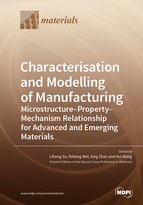Characterisation and Modelling of Manufacturing–Microstructure–Property–Mechanism Relationship for Advanced and Emerging Materials
A special issue of Materials (ISSN 1996-1944). This special issue belongs to the section "Advanced Composites".
Deadline for manuscript submissions: closed (20 February 2023) | Viewed by 25239
Special Issue Editors
Interests: advanced manufacturing; friction and wear; severe plastic deformation; microstructure/texture characterisation; advanced modelling; deformation mechanism; mechanics of materials; residual stress analysis; X-ray/neutron/synchrotron diffraction; advanced and emerging materials; high-entropy alloys; corrosion and erosion of materials
Special Issues, Collections and Topics in MDPI journals
Interests: gear anti-fatigue design and manufacturing; surface treatment techniques; micro-nano gear transmission; microstructure characterisation; grain refinement; mechanical and fatigue properties; mesoscopic mechanics modelling; fatigue foundation database and software development; machine learning; crystal plasticity
Interests: computational material science; atomistic simulation; molecular dynamic modelling; dislocation and twinning; deformation mechanism; mechanical properties; advanced materials; manufacturing techniques
Interests: severe plastic deformation; microstructure/texture characterization; finite element method; crystal plasticity; machine learning; processing–structure–property (PSP) relation
Special Issues, Collections and Topics in MDPI journals
Special Issue Information
Dear Colleagues,
This Special Issue is proposed to cover the recent developments and future opportunities in the design, manufacturing, characterisation and application of the advanced and emerging metallic materials with novel microstructure and properties that have been developed in various fields of science and industry, such as nano/ultrafine-grained materials, heterogeneous-structured materials, high-entropy alloys, or complex concentrated alloys and two-dimensional materials. In addition to the advanced experimental characterisation, the modelling and simulation of microstructure and texture evolution, phase transformation and mechanical response in a process (e.g., additive manufacturing, severe plastic deformation as well as thermo-mechanical processing) is also highly beneficial to obtain a fundamental understanding of the manufacturing–microstructure–property–mechanism relationships of these materials. Additionally, machine learning and deep learning approaches can significantly help to predict novel materials and optimise their properties.
In this regard, original research papers, short communications, and review articles on the following topics are welcome in this Special Issue (not an exhaustive list): novel material and structure design, advanced manufacturing and fabrication, microstructural characterisation and phase constitution analysis, mechanical performance and plastic deformation mechanisms, processing and property optimisation.
Dr. Lihong Su
Prof. Dr. Peitang Wei
Dr. Xing Zhao
Dr. Hui Wang
Guest Editors
Manuscript Submission Information
Manuscripts should be submitted online at www.mdpi.com by registering and logging in to this website. Once you are registered, click here to go to the submission form. Manuscripts can be submitted until the deadline. All submissions that pass pre-check are peer-reviewed. Accepted papers will be published continuously in the journal (as soon as accepted) and will be listed together on the special issue website. Research articles, review articles as well as short communications are invited. For planned papers, a title and short abstract (about 100 words) can be sent to the Editorial Office for announcement on this website.
Submitted manuscripts should not have been published previously, nor be under consideration for publication elsewhere (except conference proceedings papers). All manuscripts are thoroughly refereed through a single-blind peer-review process. A guide for authors and other relevant information for submission of manuscripts is available on the Instructions for Authors page. Materials is an international peer-reviewed open access semimonthly journal published by MDPI.
Please visit the Instructions for Authors page before submitting a manuscript. The Article Processing Charge (APC) for publication in this open access journal is 2600 CHF (Swiss Francs). Submitted papers should be well formatted and use good English. Authors may use MDPI's English editing service prior to publication or during author revisions.
Keywords
- manufacturing and processing
- advanced materials
- novel microstructure
- mechanical and fatigue properties
- deformation mechanism
- dislocation and twinning
- phase transformation
- crystal plasticity
- atomistic modelling
- numerical simulation
- machine learning










